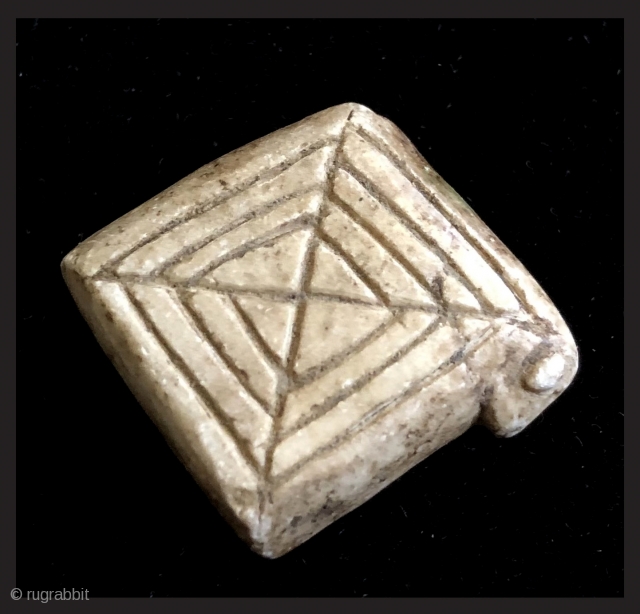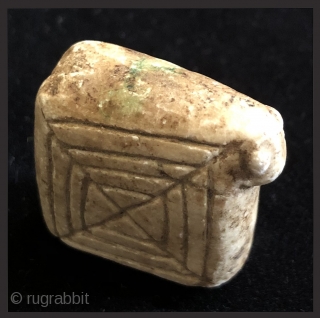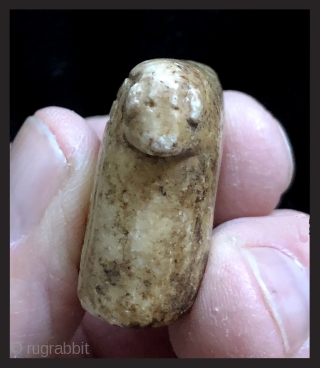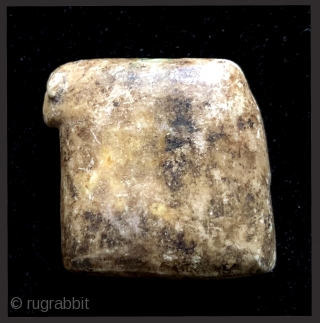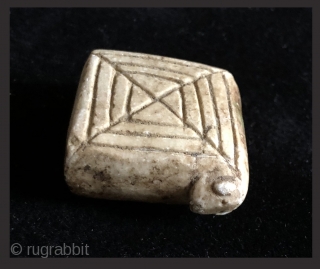Back
Carved and incised alabaster amulet. 19th century. Bolivian Altiplano. This type of fetish is called an illa (ee-ah). It was made in the shape of a generic domestic animal and incised on one side with a magical-like design of interspersed triangles and rectangles. The Aymara people who used this fetish are high altitude pastoralists whose animals are necessary for survival. Such fetishes were used in rituals seeking the help of the ancestors and deities in the protection and proliferation of their herds. The Aymara treasure their animals and have carefully bred them over the centuries for their wool and other animal byproducts. This is a small but powerful little illa with folk art-like charm. There are traces of a green pigment along the top indicating ritual use. It was carved with a basic block-like body, a head, ears, eyes and mouth - all simply fashioned. Illas often have an intentionally sweet countenance that is sensed from the simple rendering of eyes and face. This one is no exception. What is most significant though is the incised design whose meaning, is unknown to me, but not to those who carved and used this fetish in animal increase rites. The carving seems to have a magical, shamanic character to it. it's possible the lines might to have something to do with fields, irrigation channels or boundary's. Whatever the meaning this is not a common type of illa. Most illas are not incised in this way. i may have seen another somewhere along the line, but something like this - unassuming as it seems - is a rare and wonderful little ritual object. These were carved by traditional healer/shamans called Kallawayas and were employed in various rituals. Something like this would have been conserved wrapped in a sacred bundle or bag of handwoven cloth. It would have been used and reused over time and kept through generations by the owners. In the highland Andean world magic is part of life and objects such as this illa are considered vital for prosperity and survival.
price:
Inquire
- Home
- Antique Rugs by Region
- Category
- Profiles
- Post Items Free
- Albums
- Benaki Museum of Islamic Art
- Budapest: Ottoman Carpets
- Gulbenkian Museum
- Islamic Carpets. Brooklyn
- Islamic Textiles. Brooklyn
- Konya Museum: Rugs
- MKG, Hamburg
- MMA: Caucasian Carpets
- MMA: Mamluk Carpets
- MMA: Mughal Indian Carpets
- MMA: Ottoman Carpets
- MMA: Safavid Persian Carpets
- MMA: Turkmen Rugs
- McCoy Jones Kilims
- Ottoman textiles. Met
- Philadelphia Museum
- Rugs and Carpets: Berlin
- Seljuqs at the Met
- TIEM, Istanbul: Carpets
- V&A: Classical Carpets
- Vakiflar Carpets: Istanbul
- Baluch Rugs: Indianapolis
- Gallery Exhibitions
- Jaf an Exhibition
- Alberto Levi Gallery
- Andean Textile
- Christie's London: 2016
- Francesca Galloway
- HALI at 40
- ICOC Washington, DC 2018
- Jajims of the Shahsavan
- London Islamic Week April, 2018
- Mongolian Felts
- Navajo Rugs: JB Moore
- Persian Piled Weavings
- SF Tribal & Textile Art Show 2020
- SF Tribal 2019
- Sotheby's: C. Alexander
- Turkish Prayer Rugs
- Turkmen Main Carpets ICOC 2007







